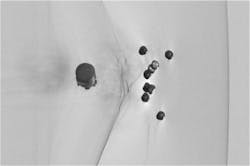Digital streak camera captures images of objects traveling 10X the speed of sound
A digital streak camera developed by researchers at MetroLaser, Inc. can capture color images of projectiles traveling up to 3,350 m/s, which is 10 times the speed of sound.
Film-based streak photography records the motion of an object as it passes in front of a camera lens, while the film moves behind a vertical slit aperture during the exposure, the result of which is a long, continuous composite of the image, according to Phys.org.
Under a Small Business Innovation Research contract from the U.S. Air Force, Benjamin Buckner and Drew L’Esperance of MetroLaser, Inc. designed the system, which can produce high-quality images of fast-moving objects faster than film-based streak cameras that are currently in use.
Digital streak photography, as developed by the duo, relies on a precisely controlled mirror to follow an object and freeze the image on camera. Bucker explains in their research paper, which is published in Optical Engineering, that the galvo mirror tracks the object as it moves past the camera and directs the right portion of the object’s image onto the right portion of the image sensor in order to form a complete, undistorted image.
The camera, which due to its optical design can even capture the wave of compressed air that is pushed along by an object, was built to meet specifications established by operators of rocket sleds, which means that the camera is able to resolve an object 1.27 mm in size when the sled is traveling 3350 m/s, and must be able to operate outdoors in conditions of heat, cold, dust, and moisture. The setup of the system involves a commercial portrait-quality digital camera, conventional photographic flash illumination, and accompanying software.
"The real power of this approach is that you can take almost any kind of existing camera back and fit it into a rig like this to turn it into a high-speed streak camera," Buckner said in the article.
Digital streak imaging could be used in ballistics, rocket sled imaging, and determining finish order in high-speed racing, according to Bucker and L’Esperance.
View the Phys.org article.
Also check out:
Researchers use high-speed camera to study water droplet dynamics
Integrator's view: Evolving vision system solutions, 3D industrial imaging, real-time data analysis
Eye-tracking cameras study impact of peacock tail display on female birds
Share your vision-related news by contacting James Carroll, Senior Web Editor, Vision Systems Design
To receive news like this in your inbox, click here.
Join our LinkedIn group | Like us on Facebook | Follow us on Twitter | Check us out on Google +
About the Author

James Carroll
Former VSD Editor James Carroll joined the team 2013. Carroll covered machine vision and imaging from numerous angles, including application stories, industry news, market updates, and new products. In addition to writing and editing articles, Carroll managed the Innovators Awards program and webcasts.
